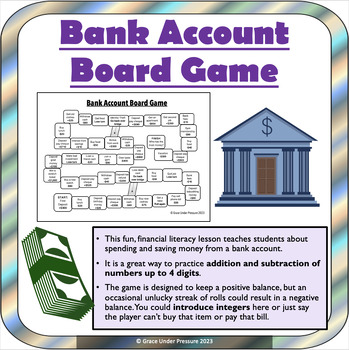Bank Account Board Game: Personal Financial Literacy Activity for Grades 3-6
- PDF
- Easel Activity
Also included in
- Are you looking to incorporate more financial literacy and budgeting into your 6th Grade Math class? Do you want to show your students how the math they learn in class (from geometry to statistics to expressions to ratios) can be applied in real world, useful situations?This is the bundle for you!ThPrice $19.75Original Price $28.00Save $8.25
- This bundle includes everything you need to introduce your elementary students in grades 3-6 to important financial literacy topics! They will create a household budget by choosing options for food, transportation, housing, clothing, etc. They will learn how a bank account works by playing a boardPrice $10.00Original Price $13.75Save $3.75
Description
Who says financial literacy is boring!?
• This fun, personal financial literacy lesson teaches grade 3-6 (or special education) students about spending and saving money from a bank account.
• It is a great way to practice lots of addition and subtraction of numbers up to 4 digits.
How to Use:
• Go through the 2-page handout to teach students about bank account vocabulary: deposit, withdraw, balance, debit card, cheque, and ATM. They can complete the activities on the worksheets to support comprehension.
• Print a board for each group of 2-4 students. Have a six-sided die to go with each board.
• Each student needs something to use as a counter on the board.
• Students roll and play the game, keeping track of how their bank account balance rises and falls based on the realistic events on the board (for example: deposit a pay cheque +$525 or join a gym -$90). They can use paper or a mini whiteboard to keep score. They will be doing so much math practice as they update their bank balance every turn.
• The game is designed to keep a positive balance, but an occasional unlucky streak of rolls could result in a negative balance. You could introduce integers here OR just say the player can’t buy that item or pay that bill.
• The winner has the most money at the end of the game.
What's Included:
4 Page PDF: ready to print!
Teacher Instructions
2 Page Worksheet about Bank Accounts
1 Page Game Board








